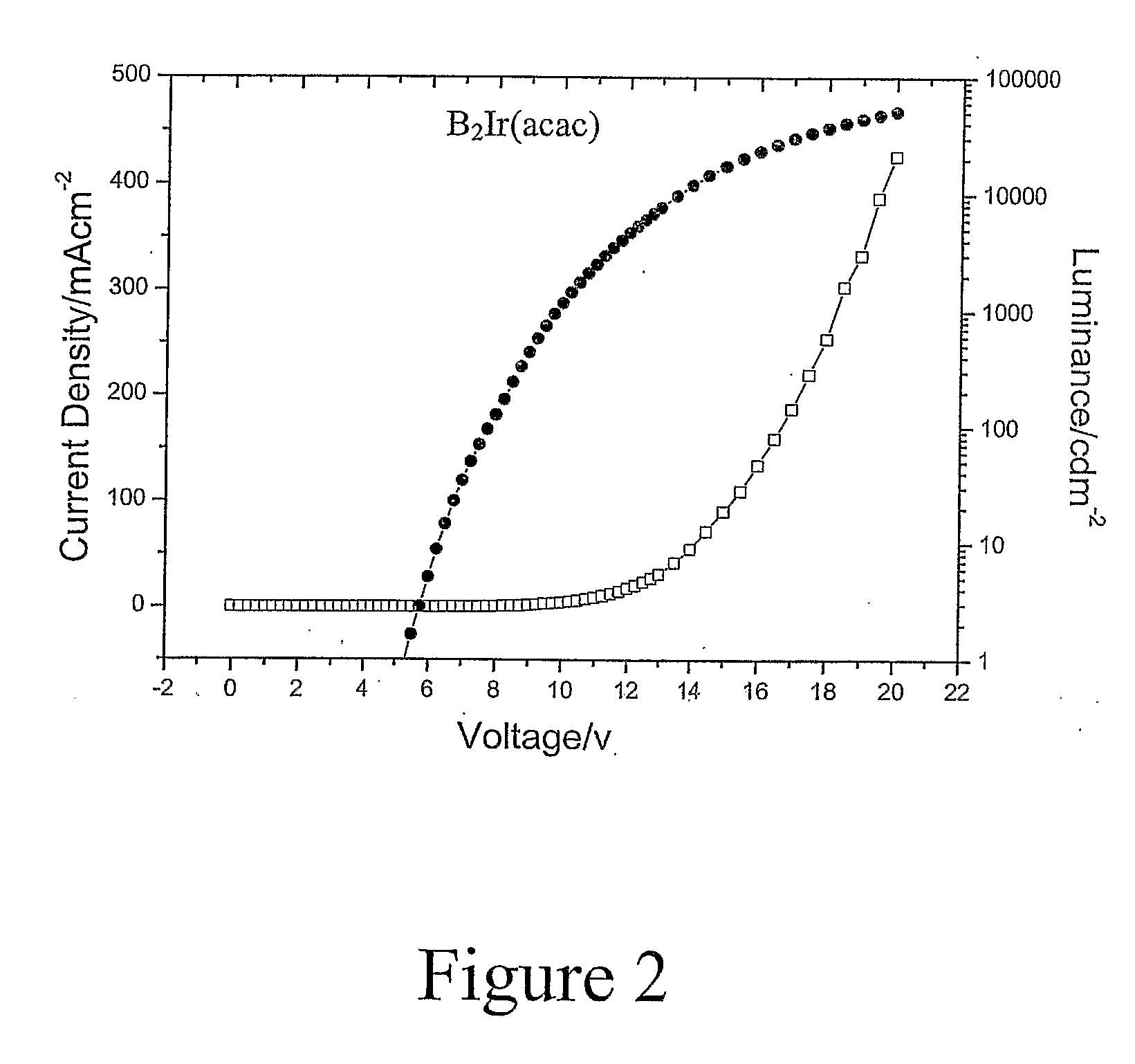Solution processed organometallic complexes and their use in electroluminescent devices
a technology of organometallic complexes and electroluminescent devices, which is applied in the direction of discharge tube luminescnet screens, electrical equipment, platinum group organic compounds, etc., can solve the problems of undetectable increase of the operating temperature of the device, loss of approximately 75% of excitons generated in the electrofluorescent device, and phosphorescence is a much slower process
- Summary
- Abstract
- Description
- Claims
- Application Information
AI Technical Summary
Benefits of technology
Problems solved by technology
Method used
Image
Examples
example 1
Synthesis of 2-(trimethylsilyl)pyridine (Compound 1)
[0125]
[0126]To a solution of 2-bromopyridine (4.74 g, 0.030 mol), CuI (0.14 g, 0.74 mmol), and Pd(PPh3)2Cl2 (0.52 g, 0.74 mmol) in 100 ml of diisopropylamine was added (trimethylsilyl)acetylene (3.0 g, 0.030 mol). The mixture was stirred at room temperature overnight under nitrogen atmosphere. After removal of the solvent under reduce pressure, the residue was purified by reduced pressure distillation to offer 5.0 g (yield 95%) of pure compound 1 of 2-trimethylsilyl)pyridine.
example 2
Synthesis of 2-(trimethylsilyl)-5-bromopyridine (Compound 2)
[0127]
[0128]To a solution of 2,5-dibromopyridine (3.56 g, 0.015 mol), CuI (0.07 g, 0.37 mmol), and Pd(PPh3)2Cl2 (0.26 g, 0.37 mmol) in 100 ml of diisopropylamine was added (trimethylsilyl)acetylene (1.47 g, 0.015 mol). The mixture was stirred at room temperature overnight under nitrogen atmosphere. After removal of the solvent under reduce pressure, the residue was purified by flash column to offer 3.45 g (yield 90%) of compound 2 of 2-trimethylsilyl)-5-bromopyridine.
example 3
Synthesis of 2-(2′,3′,4′,5′-tetraphenyl)phenyl-5-bromopyridine (Compound 3)
[0129]
[0130]To a solution of 2-(trimethylsilyl)-5-bromopyridine (1.27 g, 5 mmol) in the mixture of THF and methanol was added 1 ml of NaOH (5N). The reaction mixture was stirred for 1 hour at room temperature. Then 50 ml of ethyl acetate was added, the mixture was washed with water and brine and dried with anhydrous magnesium sulfate. After removal of the solvent, the residue was refluxed with tetraphenylcyclopentadienone (2 g, 5.2 mmol) in 50 ml of o-xylene overnight. After cooled down to room temperature, the solvent was removed by flash column and the residue was purified by recrystallization in ethanol 2-3 times to offer 2.17 g (yield 81%) of pure 2-(2′,3′,4′,5′-tetraphenyl)phenyl-5-bromopyridine (Compound 3).
PUM
| Property | Measurement | Unit |
|---|---|---|
| thickness | aaaaa | aaaaa |
| internal quantum efficiency | aaaaa | aaaaa |
| PLQY | aaaaa | aaaaa |
Abstract
Description
Claims
Application Information
 Login to View More
Login to View More - R&D
- Intellectual Property
- Life Sciences
- Materials
- Tech Scout
- Unparalleled Data Quality
- Higher Quality Content
- 60% Fewer Hallucinations
Browse by: Latest US Patents, China's latest patents, Technical Efficacy Thesaurus, Application Domain, Technology Topic, Popular Technical Reports.
© 2025 PatSnap. All rights reserved.Legal|Privacy policy|Modern Slavery Act Transparency Statement|Sitemap|About US| Contact US: help@patsnap.com



